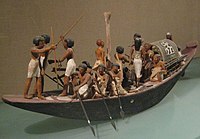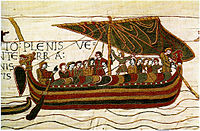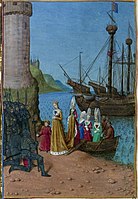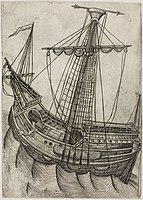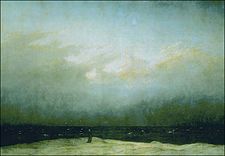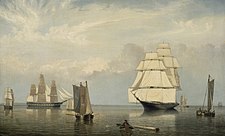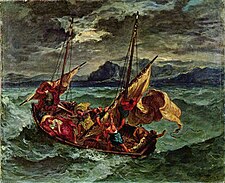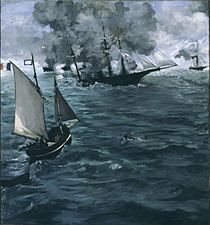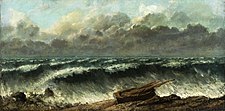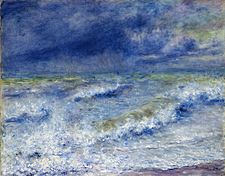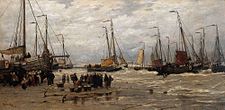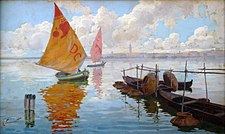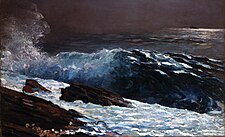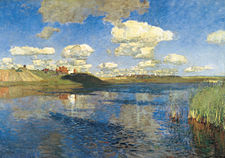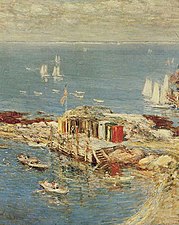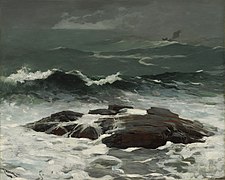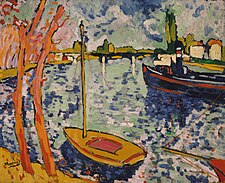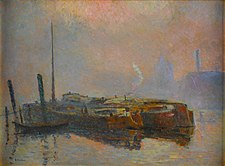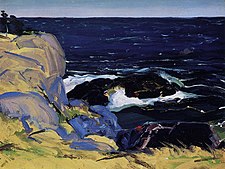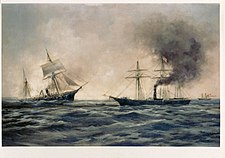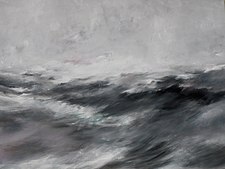Marine art

Marine art or maritime art is a form of

Ships and boats have been included in art from almost the earliest times, but marine art only began to become a distinct genre, with specialized artists, towards the end of the

Maritime art, especially marine painting – as a particular genre separate from
Earliest times to 1400
Vessels on the water have featured in art from the earliest times. The earliest known works are
Both men and gods are shown on river "barges" in
Ships sometimes appear in
From
-
Egyptian model boat, 12th dynasty,Amenemhet I
-
Nile mosaic of Palestrina (1st century BCE)
-
Norman ship of the invasion fleet, Bayeux Tapestry, 11th century
-
Shipwreck of Hugh de Boves by Matthew Paris, 13th century, English
15th century

A distinct tradition begins to re-emerge in
During the
At the same time artists were often involved in the expansion of Western
-
Nicholas of Bari
-
Engraving by Master W with the Key
-
Woodcut with colour of the Battle of Zonchio in 1499
16th century

The Netherlandish tradition of the "

An important work by a Flemish "follower of Patenir" is the Portuguese Carracks off a Rocky Coast of about 1540 (787 x 1447 mm), in the

A superb coloured drawing by Hans Holbein the Younger of a ship crowded with drunken lansquenets was perhaps done in preparation for a mural in London. This adopts the low viewpoint typical of the ship portrait.[18]

The highly picturesque and historically useful
Mannerism in both Italy and the North began to paint fantastic tempests with gigantic waves and lightning-filled skies, which had not been attempted before but were to return into fashion at intervals over the following centuries. As naval warfare became more prominent from the late 16th century, there was an increased demand for works depicting it, which were to remain a staple of maritime painting until the 20th century, pulling the genre in the direction of history painting, with an emphasis on the correct and detailed depiction of the vessels, just as other trends pulled in the direction of increasingly illusionist and subtle effects in the treatment of the sea and weather, paralleling those of landscape painting. Many artists could paint both sorts of subject, but others specialized in one or the other. However at this date seascapes showing a large portion of sea and with no vessels at all were very rare.
Maritime painting of the Dutch Golden Age

The
More often than not, even small ships fly the

The prolific workshop of Willem van de Velde the Elder and his son was the leader of the later decades, tending, as at the beginning of the century, to make the ship the subject, but incorporating the advances of the tonal works of earlier decades where the emphasis had been on the sea and the weather. The Younger van de Velde was very strongly influenced by Simon de Vlieger, whose pupil he was. The Elder van de Velde had first visited England in the 1660s, but both father and son left Holland permanently for London in 1672, leaving the master of heavy seas, the German-born Ludolf Bakhuizen, as the leading artist in Amsterdam.[25] Reinier Nooms, who had been a sailor and signed his works Zeeman ("seaman"), specialized in highly accurate battle scenes and ship portraits, with some interest also in effects of light and weather, and it was his style that was to be followed by many later specialized artists. Abraham Storck and Jan Abrahamsz Beerstraaten were other battle specialists. Nooms also painted several scenes of dockyard maintenance and repair operations, which are unusual and of historical interest.[26]
The tradition of marine painting continued in the Flemish part of the Netherlands, but was much less prominent, and took longer to shake off the Mannerist style of shipwrecks amid fantastic waves. Most paintings were small zeekens, whereas the Dutch painted both large and small works. The leading artist was

The Dutch style was exported to other nations by various artists who emigrated, as well as mere emulation by foreign artists. The most important emigrants were the leading Amsterdam marine artists, the father and son Willem van de Velde. Having spent decades chronicling Dutch naval victories over the English, after the collapse of the art market in the disastrous rampjaar of 1672, they accepted an invitation from the English court to move to London, and spent the rest of their lives painting the wars from the other side. Artists loosely said to have "followed" their style include Isaac Sailmaker, although he was a much earlier Dutch emigrant who had preceded their arrival in England by at least 20 years, and whose style is very different from theirs; as well as Peter Monamy, whose style derives from numerous marine painters besides the van de Veldes, such as Nooms, Peeters and Bakhuizen; and several others, such as Thomas Baston and the Vale brothers, who painted in the native English tradition.
Increasingly, marine art was already mostly left to specialists, with rare exceptions like
18th century
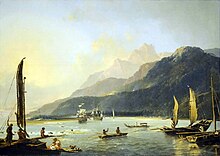
The century supplied an abundance of military actions to depict, and before the
The Venetian artists
Naval cadets were now encouraged to learn drawing, as new coastal charts made at sea were expected to be accompanied by "coastal profiles", or sketches of the land behind, and artists were appointed to teach the subject at naval schools, including John Thomas Serres, who published Liber Nauticus, and Instructor in the Art of Marine Drawings in 1805/06.[33] Professional artists were now often sent on voyages of exploration, like William Hodges (1744–1797) on James Cook's second voyage to the Pacific Ocean, and exotic coastal scenes were popular as both paintings and prints.
Prints had become as significant as a source of income as the original painting for some artists, for example the much-engraved French painter
Romantic Age to present

The Romantic period saw marine painting rejoin the mainstream of art, although many specialized painters continued to develop the "ship portrait" genre.
River, harbour and coastal scenes, typically with only small boats, were popular with

The ship portrait genre was taken to America by a number of emigrants, most English like James E. Buttersworth (1817–1894) and Robert Salmon (1775 – c. 1845). The Luminist Fitz Henry Lane (1804–1865) was the earliest of a number of artists who developed American styles based in landscape art; he painted small boats at rest in tranquil small bays. Martin Johnson Heade was a member of the Hudson River School, and painted tranquil scenes, but also threatening storms of alarming blackness. Winslow Homer increasingly specialized in marine scenes with small boats towards the end of the century, often showing boats in heavy swells on the open sea, as in his The Gulf Stream.Thomas Eakins often painted river scenes, including Max Schmitt in a Single Scull (1871).[2] Thomas Goldsworthy Dutton (1820-1891) has the reputation of being one of the finest lithographers of 19th Century nautical scenes and ship portraits.[36]

Later in the century, as the coast became increasingly regarded as a place of pleasure rather than work, beach scenes and coastal landscapes without any shipping became prominent for the first time, often including cliffs and rock formations, which had earlier been mostly found in scenes of shipwreck. Many later beach scenes became increasingly crowded, as holidaymakers took over the beaches of Europe.
The rather traditional British marine artist Sir Norman Wilkinson was during World War I the inventor of dazzle camouflage, by which ships were boldly painted in patterns, achieving results not dissimilar to Vorticism, inspiring the naval ditty: "Captain Schmidt at the periscope / You need not fall or faint / For it’s not the vision of drug or dope / But only the dazzle paint".[38] When the American navy adopted the idea in 1918, Frederick Judd Waugh was put in charge of design.
Specialized marine painters concentrating on ship portraits continue to the present day, with artists such as
19th century gallery
-
J. M. W. Turner. The Jetty of Calais, 1803
-
J. C. Dahl, Entrance to Copenhagen, 1830
-
Christen Købke, View of Lake Sortedam, 1838
-
Eugène Lepoittevin, Shipwreck off the Cliffs of Dover at Night with Dover Castle in the Distance, c. 1840
-
Fitz Henry Lane, Salem Harbor, 1853
-
Alexey Bogolyubov, Battle of Athos, 1853
-
Eugène Delacroix, Christ on the Sea of Galilee, 1854
-
Édouard Manet, Battle of the Kearsarge and the Alabama, 1864
-
James Abbott McNeill Whistler, Harmony in Blue and Silver:Trouville, 1865
-
Gustave Courbet, Autumn Sea, 1867
-
Gustave Courbet, The Waves, 1869
-
Albert Bierstadt, San Francisco Bay, 1871-1873
-
Max Schmitt in a single scull, 1871
-
Hans Gude, Sailing into Oslo Fiord, 1872
-
Arkhip Kuindzhi, Lake Ladoga, 1873
-
Thomas Eakins, Starting Out After Rail, 1874
-
Pierre-Auguste Renoir, The Wave, 1879
-
Hendrik Willem Mesdag, Pinks in the breakers, c. 1880
-
Claude Monet, The Cliffs at Étretat, 1885
-
Eugène Boudin, Ships at Le Havre, 1887
-
Enrique Simonet, Venetian marine, 1887-1890
-
Winslow Homer, Sunlight on the Coast, 1890
-
Eugène Chigot, Stranded in Heavy Weather (Échouage par gros temps) 1892
-
The Seineat Port-Villez, 1894
20th century gallery
-
Isaac Levitan, Lake. Russia 1900
-
Leon Dabo, The Seashore, ca. 1900
-
Childe Hassam, August Afternoon, Appledore, 1900
-
Camille Pissarro, Morning, Winter Sunshine, Frost, the Pont-Neuf, the Seine, the Louvre, Soleil D'hiver Gella Blanc, c. 1901
-
Winslow Homer, Summer Squall, 1904
-
Maurice de Vlaminck, The River Seine at Chatou, 1906
-
Robert Antoine Pinchon, Péniche dans la brume, before 1909, Musée des Beaux-Arts de Rouen
-
Paul Signac, Antibes, the towers, 1911
-
Eugène Chigot',Voiliers au Port (sailing boats in the port), 1911
-
George Bellows, West Wind, 1913
-
Henry Scott Tuke, Four Masted Barque, 1914
-
William Lionel Wyllie, The Track of Lusitania. View of Casualties and Survivors in the Water and in Lifeboats, 1915
-
Alexander Benois, On a deserted, wave-swept shore..., 1916
21st century gallery
-
Ingo Kühl, Seebild 2014
East Asian traditions
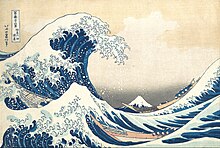
As noted above, a river with a small boat or two was a standard component of
The turning-away from long-distance maritime activity of both the Chinese and Japanese governments at the time of the Western Renaissance no doubt helped to inhibit the development of marine themes in the art of these countries, but the more popular Japanese
See also
- British Marine Art (Romantic Era)
- Half Hull Model Ships
- Seascape
- Category:Marine artists
- Category:Maritime paintings
Notes
- ISBN 0-295-97656-X, 9780295976563 [1](accessed Jan. 15, 2009 on Google Book Search)
- ^ a b c d e "Grove": Cordingley, D., Marine art in Grove Art Online. Accessed April 2, 2010
- ^ Russell, Margarita: Visions of the Sea: Hendrick C. Vroom and the Origins of Dutch Marine Painting. (Leiden: Brill Academic Publishers, 1983)
- ^ Keyes, George S.: Mirror of Empire: Dutch Marine Art of the Seventeenth Century [exh. cat.]. (Minneapolis: Minneapolis Institute of Arts; Cambridge: Cambridge University Press, 1990)
- ^ Giltaij, Jeroen; Kelch, Jan; et al. (eds.): Praise of Ships and the Sea: The Dutch Marine Painters of the 17th Century [exh. cat.]. (Rotterdam: Museum Boijmans Van Beuningen, 1997)
- ^ Russell, 4
- ^ Russell, 51
- ^ Hall, 84-85
- ^ Clark, 31-32
- ^ Kren, 84, note 1. Châtelet, 34–35 and 194–196 – both are illustrated there.
- ^ a b Russel, 53
- ^ McDonald, 104-105,British Museum highlights Archived 2015-10-18 at the Wayback Machine
- ^ The Greenwich Portuguese carracks - see next section.
- ^ Russell, 24-32
- ^ Russell; this is the main theme of here chapter 2, especially pp. 45-46
- ^ Russell, 40-41, and Grove
- ^ National Maritime Museum Archived 2010-06-17 at the Wayback Machine; see also Grove.
- ^ Stadel, Frankfurt, Holbein drawing, see also Russell, 53, and illus. p.54
- ^ The conventional view, although Russell seems unpersuaded of this, see p. 43
- ^ Slive, 213
- ^ Slive, 213, the start of his chapter 9, which is devoted to Marine painting
- ^ Slive, 213-216
- ^ Russell, 57-61
- ^ Described in Slive, 216-220
- ^ Slive, 220-224
- ^ Slive, 223
- ^ Vlieghe, 198-200
- ^ Slive, 214
- ^ Vlieghe, 178 and 199-200
- ^ Grove; Slive, 213
- Moby Dick.
- ^ Harold Osborne, Anthony Langdon. "Marine painting", in The Oxford Companion to Western Art, Ed. Hugh Brigstocke. Oxford University Press, 2001. Oxford Reference Online. Oxford University Press. accessed 5 October 2010 [2]
- ^ Taylor, 134-135
- ^ Andrews 177-178; Snowstorm.
- ^ Philadelphia Museum of Art Retrieved April 8, 2010
- ^ T.G.Dutton
- ^ "Lot 123: Eugène Moodeste Edmond Le Poittevin, Bathing in Étretat". www.sothebys.com.
- ^ Article (see end) by Archived 2010-12-06 at the Wayback Machine Andrew Graham-Dixon
- ^ Andrews, 21, and Most Wanted and Least Wanted Paintings
References
- Andrews, Malcolm. Landscape and Western Art, Oxford History of Art, Vol 10, Oxford University Press, 1999, ISBN 978-0-19-284233-6
- Châtelet, Albert. Early Dutch Painting, Painting in the Northern Netherlands in the Fifteenth Century, 1980, Montreux, Lausanne, ISBN 2-88260-009-7
- "Grove": Cordingley, D. Marine art in Grove Art Online, accessed April 2, 2010
- Clark, Sir Kenneth. Landscape into Art, 1949
- Hall, James. A History of Ideas and Images in Italian Art, 1983, John Murray, London. ISBN 0-7195-3971-4
- T Kren & S McKendrick (eds). Illuminating the Renaissance: The Triumph of Flemish Manuscript Painting in Europe, Getty Museum/Royal Academy of Arts, 2003, ISBN 1-903973-28-7
- McDonald, Mark. Ferdinand Columbus, Renaissance Collector, 2005, British Museum Press, ISBN 978-0-7141-2644-9
- Royalton-Kisch, Martin. The Light of Nature, Landscape Drawings and Watercolours by Van Dyck and his Contemporaries, British Museum Press, 1999, ISBN 0-7141-2621-7
- Russel, Margarita. Visions of the Sea: Hendrick C. Vroom and the Origins of Dutch Marine Painting, Brill Archive, Leiden, 1983, ISBN 978-90-04-06938-1
- ISBN 0-300-07451-4
- Taylor, James. The Voyage of the Beagle: Darwin's Extraordinary Adventure in Fitzroy's Famous Survey Ship, Anova Books, 2008, ISBN 978-1-84486-066-1
- Vlieghe, Hans (1998). Flemish Art and Architecture, 1585-1700. Yale University Press Pelican history of art. New Haven: Yale University Press. ISBN 0-300-07038-1
Further reading
- E. H. H. Archibald: Dictionary of Sea Painters(Woodbridge, 1981) .
- D. Cordingly: Marine Painting in England: 1700–1900(London, 1974).
- A. S. Davidson: Marine Art & Liverpool Painters, Places & Flag Codes, 1760-1960 (Wolverhampton 1986)
- W. Gaunt: Marine Painting: An Historical Survey(London, 1975).
- J. Taylor: Marine Painting: Images of Sail, Sea and Shore(London, 1995) .
- J. Wilmerding: A History of American Marine Painting(Boston, MA, 1968) .
External links
 Media related to Marine art at Wikimedia Commons
Media related to Marine art at Wikimedia Commons

